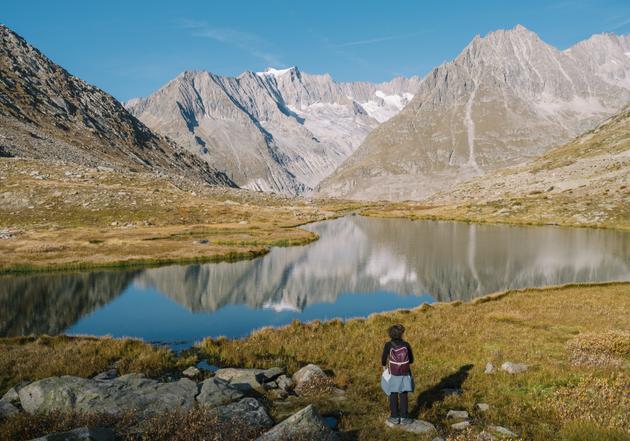


Le Monde's top 10 destinations | #4 Switzerland's Aletsch Glacier
FeatureWhere to travel in 2024? This year, Le Monde answers that question with 10 travel picks accessible by train from France. Discover two travel guides per week throughout December. Number 4: Europe's largest glacier, the Aletsch.
Taking in the view from the nearby summits is an emotional experience. But stepping out onto its ice induces a thrill of an entirely different kind. Coming into contact with the Aletsch Glacier, Europe's largest, is a truly ceremonial experience. It originates from beneath the highest mountains of the Swiss Valais, forming a 22-kilometer-long, 11 billion-tonne ice mass with an area of 81 square kilometers.
After an approach walk in bright autumn sunshine at an altitude of 2,300 meters, it was time to put on a jacket and hat. Like a frozen river flowing from the Jungfrau and Mönch peaks in the distance, the glacier occupies the entire width of the narrow valley. The wind rushing through this corridor quickly freezes you to the ground. Next, put on gloves to prevent injuries from sharp ice in case of a fall. You also need crampons to grip the ground, which becomes as slippery as an ice rink. Finally, rope up with fellow companions, as side-stepping is not a good idea.
When seen from above, the Aletsch giant may appear as flat as it is serene, but its terrain is, in reality, tumultuous, going from hollows to humps, from thin plunging edges to plateaus, and from recesses to ridges. Invisible crevasses cut through its 300-meter thickness here. The roped party cautiously navigated this new world. "It's another planet," said 57-year-old Alexandra Peclat, one of the group. Despite often following her paragliding husband up the Valais slopes, she was moved to tears by her first experience of this extraordinary natural space, which she had admired from a distance many times.

From every direction, there were sounds of crunching and cracking. The natural silence was also punctured with the muffled, rolling sound of water flowing somewhere beneath the crampons. This soundtrack was not unrelated to the emotion that gripped the day's explorers. Indeed, like all the glaciers in the Alps, the Aletsch Glacier was melting due to global warming. The Swiss giant formed 24,000 years ago when the entire Rhône valley and the side valleys of the Valais were covered by an enormous ice cap, with only the highest peaks – the 4,000-meter peaks the region is famous for – emerging like arrowheads.
For thousands of years, a meter of fresh snow has fallen at the top, frozen and then thawed several times, forming a centimeter of ice in the space of 10 years. Gravity then sets this ice in motion downstream, like honey on toast, at a speed of 200 meters a year. This perpetual movement carries summit rocks downward, creating moraines – long stripes cutting through the icy expanse and shaping this majestic landscape. This giant once thrived so well that it threatened meadows and pastures. At the end of the 17th century, Fiesch residents in the valley made a wish to "banish the glacier" and prayed to Pope Innocent XI to stop its advance.
You have 65% of this article left to read. The rest is for subscribers only.
